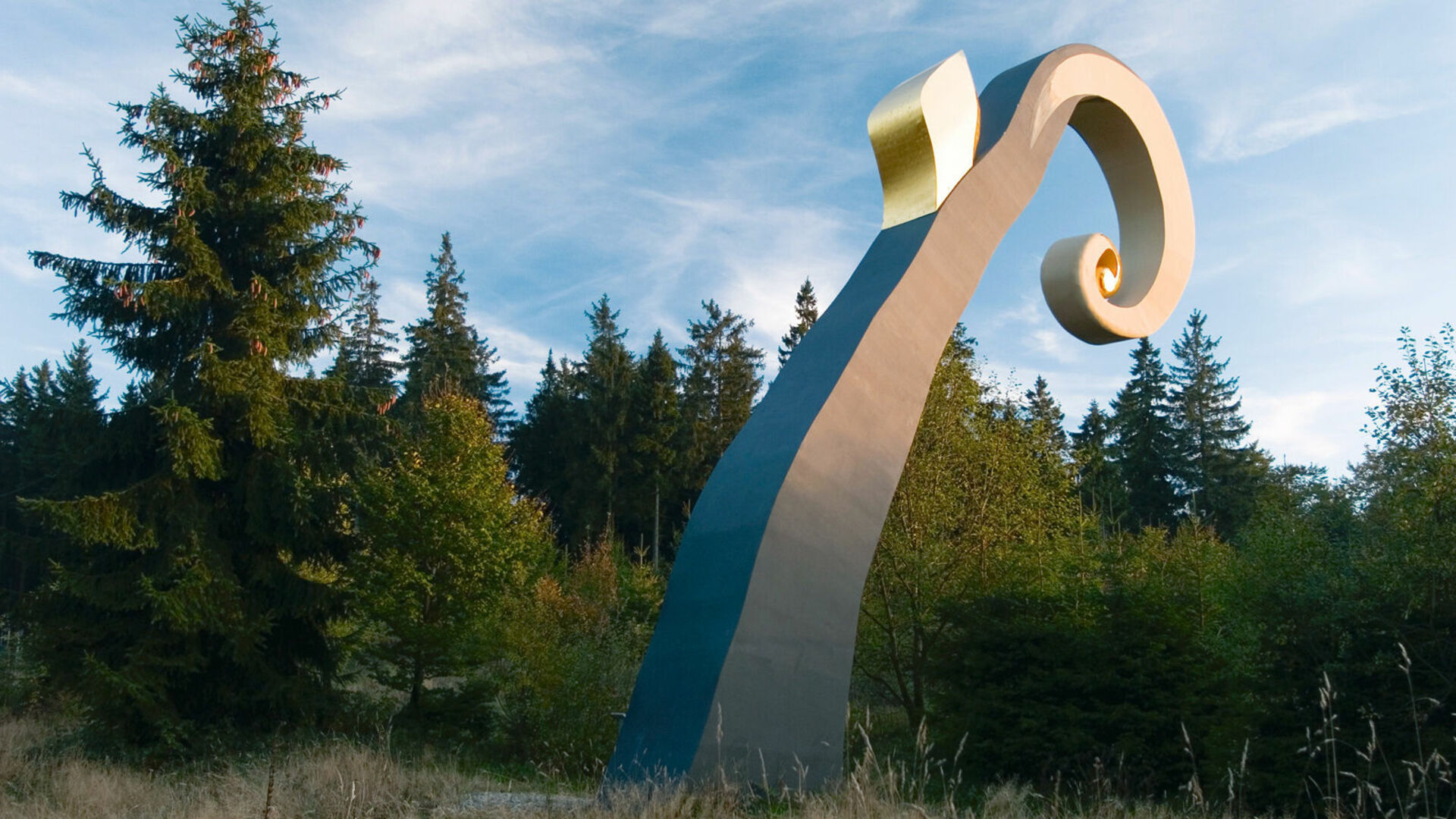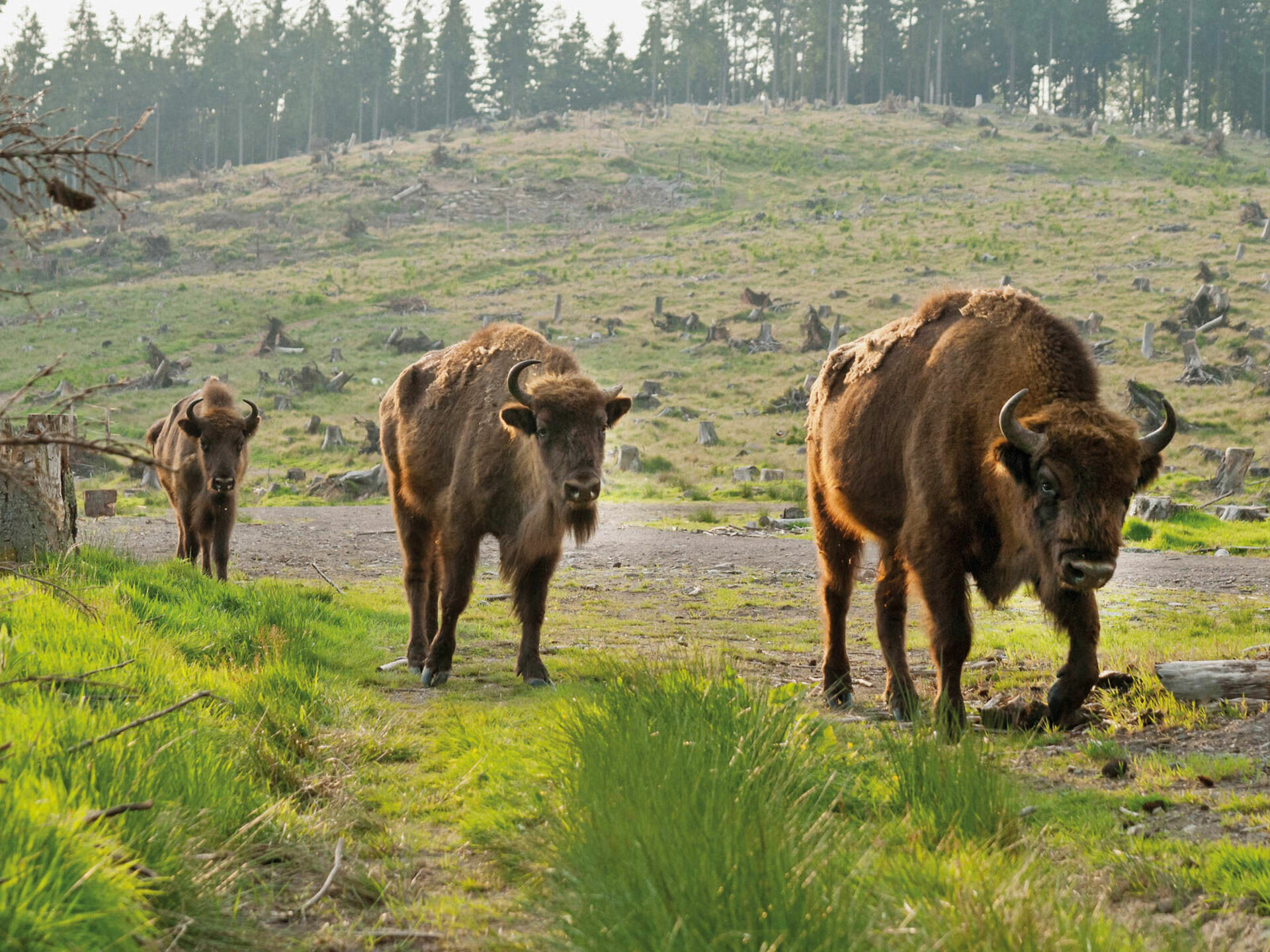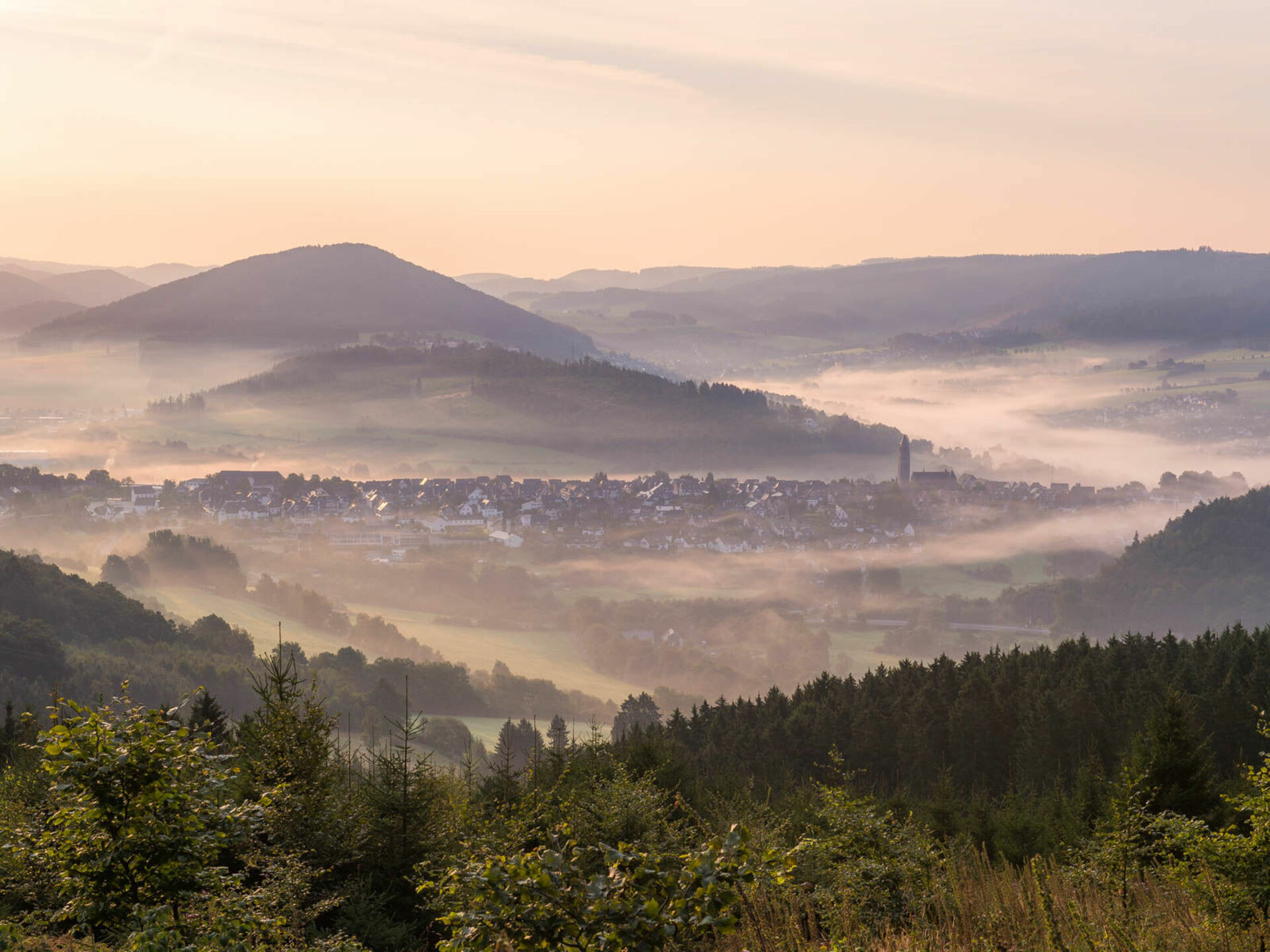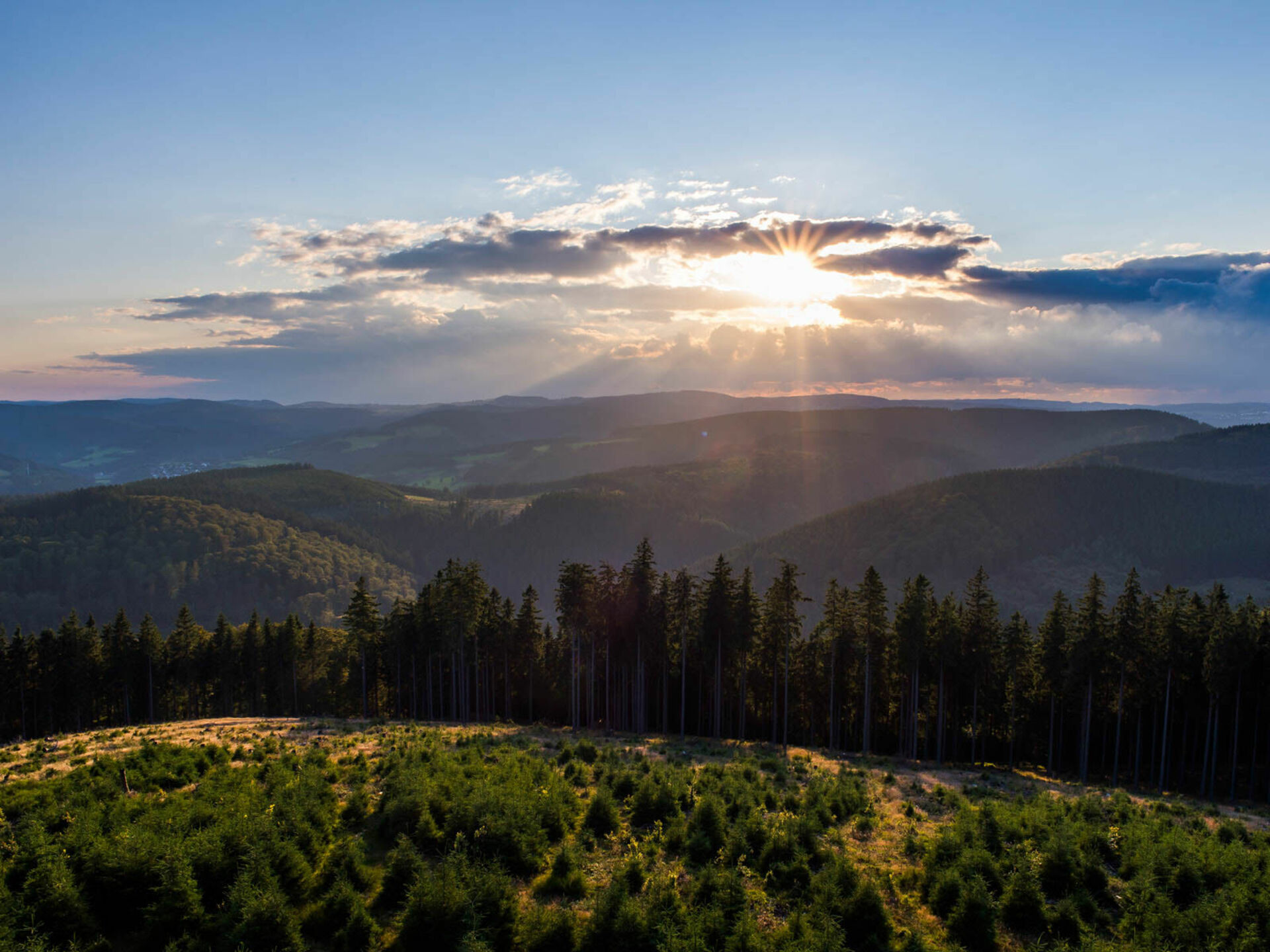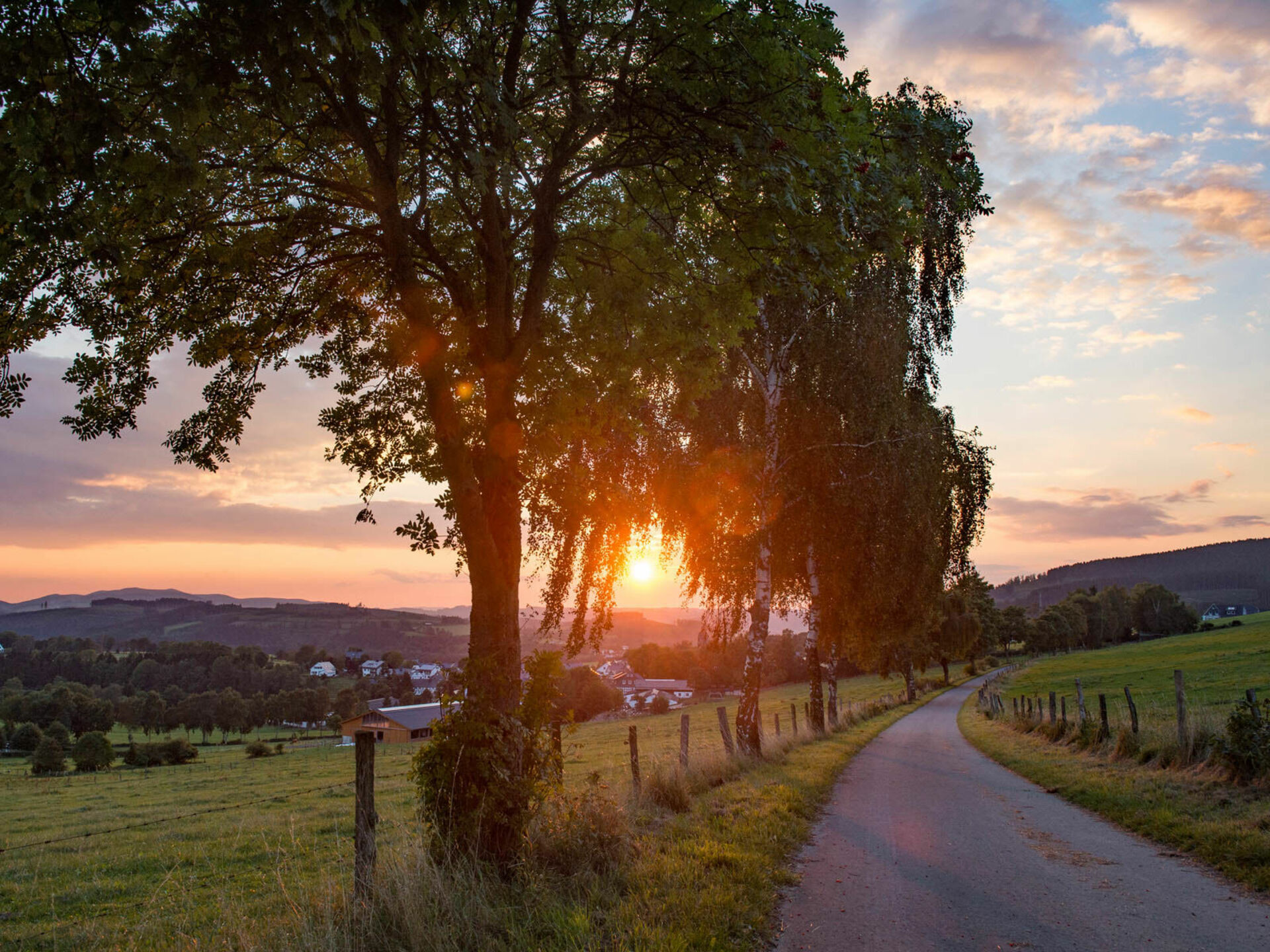The Wood Sculpture Path
Wittgenstein-Sauerland
The Wood Sculpture Path, created between 2000 and 2010 leads from Bad Berleburg in the Siegerland-Wittgenstein district and Schmallenberg in the Sauerland. On the Rothaarsteig access paths from the two towns, it takes just 23 kilometres to cross the Rothaar ridge, on which it also crosses the Rothaarsteig at Kühhude. With their works of art along the edge of the Wood Sculpture Path, internationally known artists have created a unique artistic hiking trail which, in Germany at least, is unique. During the project, which has run over a number of years, all 11 works of art have now been completed. The artists were thus given sufficient time for them to create first class results. The landscape surrounding the works of art is above all characterised by spruce in the area of the ridge and by mixed woods in the valleys. Use the Wood Sculpture Path as a gateway to a holiday on both sides of the Rothaar ridge. Because both locations, Bad Berleburg in the Wittgenstein area and Schmallenberg in the Sauerland have a great deal more to offer.
The sculptures
The Competition
2002 - 2004
For centuries, faith, culture and the Rothaar ridge separated the inhabitants of Bad Berleburg und Schmallenberg – almost until today. In order to create a bridge between identities, traditions, and prejudices, the concept artist Jochen Gerz invited the people from both places to send a letter about the Rothaar ridge to the people in the other town, and in this letter to write about what they associated with the term 'home', for example. These letters were then displayed on signs in the town on the other side of the Rothaar ridge. Their subjects: feelings, experiences, events, and memories from people on the sometimes difficult path from one side to the other. The project "The Competition" forms the start and end point of the Wood Sculpture Path.
Over the Ponds
2001
A mysterious sound carpet of tones shimmers over the long valley at Kloster Grafschaft abbey. The whispers from the woods and meadows are joined to mystical sounds which seem to have a natural origin, and yet are so unfamiliar. Their secret disappears only when you are directly in front: They emanate from the sound sculpture "Over the Ponds", a circle of tall copper pillars which the artist Andreas Oldörp has constructed according to the principles of organ pipes, and has installed in the Bremecketal valley. Sound, sense, and feel show the rambler the way to enjoyment of art in the natural openness of the wooded valley.
“Blinker II“. A Light Show Theatre
2007-2010
Nature is in charge here: „Blinker II“ is a light-kinetic sculpture which consists of a 1000 by 1183.5 cm steel structure with 196 movable mirrors made of polished stainless steel, each measuring 50 by 83 cm. The individual panels as well as the total area of the lamella wall with a size of 719.5 by 1183.5 cm have the proportions of a standard cinema screen. On them, the elements of nature, light and air, the sun and the wind, heaven and earth, give a waving and blinking performance in an atmospheric spectacle of nature of dazzling array (similar to the Cuxhaven tidal object „Blinker I“ created in 1982 which consists of mobile mirrors swimming in the water).
Witches' Place
2003
Chimneys which project from the forest floor, a weather vane, gates made from large oven forks, and a giant inverted witch's cauldron made from opened books of spells - in a small valley surrounded by paths - Lili Fischer fills the location always known as the "Witches' Place" with the leftovers of a supposedly lost witches' village. Her work bears witness to the legend of witches, and transports ramblers into a world of fairytales and magic. However, at the same time, it also draws attention to the gruesome persecution of people during the time of the trials of witches: At the other side of the hollow is the "interrogation place" where suspected witches were once condemned to death.
The Crosier
2005
"AN EXCESSIVE POWER COLLAPSES UNDER ITS OWN WEIGHT". This quotation from Martin Luther decorates Heinrich Brummack's 7.50m high "Der Krummstab" (The Crosier), which has the appearance of being unstable in form. The crosier is one of the insignia of a bishop of the Roman Catholic church. In 1072 it was awarded to the Benedictine abbey Kloster Grafschaft as an emblem of care. In the course of the centuries, it increasingly became a symbol of the power of the Church. With the confiscation of church possessions as part of the secularisation in 1803, this temporal influence - and with it, the abbey's crosier - were lost. 2,613 kg of aluminium were processed to create the sculpture, which on the path between Schmallenberg and Bad Berleburg forms a landmark conspicuous from afar. HONSEL GMBH & CO. KG, a company from Meschede, made the 2,613 kg of AlMg3 aluminium available free of charge.
The Crosier
No Easy Game to Play
2000
Ansgar Nierhoff's steel sculpture "No Easy Game to Play", almost 4 metres in height and weighing 64 t stands in the middle of the wood on the Rothaar ridge as a surprising symbol of the conflict between the territorial, linguistic, cultural, and religious separation of the Sauerland and Wittgenstein regions over the centuries. A solid steel wall is broken into a large central gate, two smaller gates, and two blocks. The observer can see that: all parts match each other, create an Inner and an Outer, and encourage access. The dialogue between the individual forms of the sculpture is multiplied by the dialogue with the space surrounding them - nature. This contrast enables discoveries, comparisons, and recollections, different for each visitor. The location characterised in this way, close to a crossing of routes on old borders, makes ramblers participate in the commonality of the once separate regions, and in the overcoming of boundaries.
Stone-Age-Man
2001
The sculpture "Stone-Age-Man" by the artist Nils-Udo almost has the effect of an ancient temple: In the middle of the wood is an enormous cube of rock framed by a monumental architectural trunk form. The quartzite monolith weighs in at almost 150 t and, integrated into the peaceful grandeur of the forest, it forms a monument and memorial in its own right: its size, its timeless association with the earth, and its uniqueness. When exposed to this powerful entity, the rambler experiences his own temporality and vulnerability.
The Green Station
2006
"The Green Station" is a bright green house, very modest architecturally, which has completely grown into the surrounding habitat. The sculpture was conceived by the artist Gloria Friedmann, who has made nature and the relationship between man and nature into the subject of all her work. Through the tangled green of the woodland, the little house closed on three sides appears to be a monochromatic symbol, on approach to be a sculpture, and to be a shelter for a rest when you are in front of it. This impression is increased by the rustic and simple installation. As a refuge in a thunderstorm, however, the Green Station is not recommended: The rendering and structural panels are supported by a solid steel frame. The company EJOT Baubefestigungen GmbH from Bad Laasphe undertook the sponsoring for the installation of the sculpture and the coordination of all building activities. In addition, the company made personnel available for the installation, as well as bolts and fastening equipment.
The Monument of the Lost Falcon
2005
Only from a bird's eye view is it possible to fully comprehend the 44 x 28 m "Monument of the Lost Falcon". The New York artist Alan Sonfist has modelled the silhouette of a hovering falcon using earth walls in a clearing in the Wittgenstein forest. The earth walls suggest the defensive mounds of the Celtic fortifications in the immediate surroundings, and were planted with tree species which used to dominate the woods in the region, but which have been supplanted through man's activities. Sonfist uses the fencing which follows the silhouette in order to protect his work symbolically from man and beast, who have often irretrievably caused the primitiveness of nature to be lost for ever, either from human intervention or from grazing.
What Came First?
2007-2009
The artist Magdalena Jetelová symbolises the creation of life, and its eternal cycle with a golden egg, about 6.5 m in height and around 4 m in diameter. The egg's size and the reflections of light shape its presence so that it has the effect of an initial element and prototype of life in the landscape, of which it becomes a part. Reduced to what matters, it becomes a symbol and allegory of nature, the creator and maintainer of life. A foundation of reinforced concrete was created as a firm base for the statue, and the stability of the sculpture itself is provided by an internal steel skeleton. The surface consists of synthetic and cast resin with a fibreglass inlay, and was modelled using the lamination process in the workshop of Magdalena Jetelová before being coated with gold leaf.
The region
Südwestfalen
Bad Berleburg
Wondrous world on the Rothaarsteig
The romantic Kneipp spa and the beautiful holiday region of Bad Berleburg – the magical world on the Rothaarsteig, is in the middle of the Rothaargebirge natural park, nestling in one of Germany's most afforested landscapes. Beautiful landscape and largely unspoilt nature make the old royal town and its picturesque half-timbered houses in the surrounding villages especially attractive.
The splendid baroque castle of the princes of Sayn-Wittgenstein is the focal point of the historic old town, and today it still characterises the town's image. The delightfully located Schlosspark, which today is used as a park by the Spa, has trees which are hundreds of years old. It is an open invitation to walking and lingering, and every step is a memory of the rich traditions of the past. The healthy surroundings of Bad Berleburg with their mild yet bracing climate, and the clear waters of the mountain streams create the perfect conditions for undertaking invigorating activities. The Bad Berleburg rehabilitation clinics, principally under the management of the Wittgensteiner Kliniken, are famous all over Germany for their first class, modern medical and therapeutic services. The HELIOS private clinic, integrated into the Wittgenstein district hospital, offers an additional service which is up to hotel standards; this is is unique in the region. The visitor to Bad Berleburg has inexhaustible opportunities to shape his stay from day to day. There are more than 800 km of marked hiking paths in the Rothaargebirge natural park for the visitor, with 24 parking places available to the hiker. Relaxing calm and unspoilt nature for the hikes are guarantees of an incomparable nature experience. As an intersection point of the long interregional hiking routes - E1 (European long distance path), the path of German unity, the Rothaarsteig, and the Wittgenstein-Sauerland Wood Sculpture Path, there is a magnificent hiking world here. The Berleburg castle in Bad Berleburg The choice of hiking trails ranges from short circular paths to the Wittgenstein Panorama Way, a 154 km trip over several days, which brings the hiker up to a height of 800 metres over the mountain ridges of the Wittgenstein region, and offers fantastic views. The new highlight of the hiking world is the Rothaarsteig, which promises "New hiking along new paths", and as the "Route of the senses" creates a new and real dimension in hiking. Another challenging hiking route is the Wittgenstein Slate path. This 15 km circular hiking route is a search for clues through the centuries, with fascinating experiences, impressions, and discoveries of nature. It has been honoured as a Premium route with the Deutsches Wandersiegel award, The 180 km Ederauen cycle route, one of the most beautiful cycle routes along river valleys, passes through Bad Berleburg and provides breath-taking impressions of an unspoiled landscape blessed by nature. Another hiking highpoint has just been created. The Via Adrina - it lies in the lower Eder valley, and leads around the loops of the Eder – it is above all a hiking route of "visual relationships". There are more than 100 hosts, from holiday apartments, to well loved and cosy guesthouse farms, to comfortable hotels, all of whom look forward to welcoming guests to Bad Berleburg.
Schmallenberg
The Schmallenberger Sauerland
The history of the ancient town in the upper Sauerland is more than 750 years old. Already by 1200 farmers and craftsmen were settled on the "Smalen Berg", and they developed into communities which today are proud to belong to the "Historische Städte in NRW" (Historic towns in North Rhine-Westphalia) group (as is Bad Berleburg at the other end of the Wood Sculpture Path).
In particular, the old core is characterised by the visually satisfying enclosed townscape and the architecture using much local slate. All around, the holiday region of the Schmallenberger Sauerland hiking world, with over 6,000 guest beds plus a new easily oriented and attractive system of hiking routes, offers far-famed gastronomy and family-run hotels with a particularly homely and fine touch.
Rothaarsteig
The way of the senses and the feelings
Rothaarsteig - that means 154 km of pure hiking experience. A new and real dimension in hiking from Brilon in the Sauerland via the Wittgenstein mountains and the Siegen region as far as Dillenburg at the foot of the Westerwald. The Route of the Senses really offers much more than any ordinary hiking route. With its own philosophy and design, and with three of the 11...
exhibit points of the Wood Sculpture Path, it is certainly a first-in-class in a new generation of hiking routes. Between Schmallenberg-Schanze and Bad Berleburg-Kühhude, the sculptures "No Easy Game to Play" by Prof. Ansgar Nierhoff, "The Crosier" by Heinrich Brummack, and "Stone-Age-Man" by Nils-Udo decorate the Rothaarsteig. In addition to these sculptures, the Rothaarsteig provides a wealth of natural, cultural, and historically relevant starting points, numerous panorama points over the rolling landscape, and experience-learning woodcraft presentations on the natural subjects of wood and water. In short, there are enough paths and routes to be able to relax actively. The wooden couches and sofas in the Rothaarsteig design invite you to forget the stress of day-to-day living, to allow the soul to wander, and to experience nature with all your senses.
Siegen-Wittgenstein
Southern Westphalian spa and wellness landscapes
"Holiday, hiking, taking a cure, relaxing...and experiencing more"
Endless woods which really stretch from horizon to horizon, in one of the most afforested regions of Germany. Mountains like an oversized mogul ski run up to 800 metres in height. Fresh and healthy air, perfect for taking in lungfuls: Welcome to the southernmost tip of Westphalia: in the Siegerland and Wittgenstein mountains, with the Rothaargebirge natural park and the springs region of Eder, Lahn and Sieg.
What can the guest and holidaymaker discover and experience?
There is an enticing range of tourism activities at every time of year: From a first class hotel to a country inn, a cosy guest house or a stay on a farm, there is a huge choice to suit every taste (and pocket)! And in the landscape of the Mittelgebirge, every season has its own particular charm. From spring until autumn, the ideas for a relaxing stay in the Mittelgebirge countryside are almost inexhaustible. The suggestions range from "Fit & Active", to "Westphalian Enjoyment", "Cycling" and "Hiking", and the visitor is often spoilt for choice. Culture in the "province full of life" is a good deal more extensive than one might initially guess. There is a full gamut of cultural activities waiting to be discovered. 72 museums and "home museums" maintain so much that is beautiful and original, where the past can be sensed at every step.
Up hill and down dale on two wheels
In the rolling Siegerland and the Wittgensteiner uplands, the mountains are your constant companions. So there's plenty to challenge the cycle tourist! But whoever cycles along the many river valleys of this well watered region will have surprisingly pleasant stretches ahead of them. It is well worth travelling on the Rhein-Sieg-Express from Cologne to Siegen, Hagen to Siegen, or Frankfurt to Siegen (with the bicycle as luggage). Then take the "Rothaar-Bahn" railway line (there is no charge for the bicycle, by the way) to travel onwards to the ridge of the Rothaar mountains. From here, there are cycle tours over one or many days along the river Sieg to the Rhine, the Lahn to the Rhine at Koblenz, and along the Eder towards Kassel on the Fulda.
The Siegerland-Wittgenstein hiking paradise....because that is where hiking is so much fun!
Welcome to one of the most heavily forested areas of Germany, with 64% woodland. The best woods are a gift from nature, and in the Mittelgebirge countryside with its Rothaargebirge natural park, they are just waiting to be walked in. The area contains the headwaters for the Eder, Lahn and Sieg rivers, and there are more than 3,500 km of marked hiking trails through almost unending deciduous and evergreen woods. On Shanks's pony, you can make multi-day tours on the Rothaarsteig - the "Route of the Senses" (154 km), the Siegerland High ring (140 km), or the Wittgenstein Panorama Way (154 km). For nature lovers, natural history walks with many species of flora are offered in extended woodland areas, long stretches of mountain landscape, or idyllic open valleys.
The Sauerland
Sport and enjoyment in nature
To allow the soul to wander, to immerse oneself into the sensuousness of the forest, and to open oneself up to the sounds and scents of a unique landscape. Just to forget the everyday rush on hidden ways and paths, and to let nature work its magic on you. In winter, stamp your way through the crunching snow in the bracing cold. The Rothaarsteig, "The Flagship of All Hiking Paths" in the Sauerland, offers you this and much, much more, located right in the middle of the most important holiday region in North Rhine-Westphalia. Anyone who prefers to investigate the rolling countryside of the Sauerland at a higher speed, with its hills, mountains, forest, and valleys, can select one of the 30 routes of the Bike Arena Sauerland. Routes of every type and difficulty await the mountain biker. Just like sport and racing cyclists, families with children and senior citizens, will find something to suit them. Trekking and racing bikes can also be used in the Bike Arena: there are lovely runs with attractions and places for a break. Cyclists can tour the seemingly endless Sauerland forests through pure air, and let their gaze wander over valleys, hills, and beautiful half-timbered villages, and across to the sparkling waters of the many streams, rivers, lakes, and reservoirs. Seen from vantage and viewing points, the landscape seems like the swells of a green sea. This is where to fill up with freshness and energy. And the Sauerland has a great deal to offer the motorcyclist. The Sauerland Roadbook describes attractive routes, developed by the police, in varied countryside with stimulating destinations. But the main theme of a Sauerland holiday remains the forest - it covers 62 percent of the surface. According to the Forest Damage Report, it is among the healthiest in Germany. Forestry and wood-processing industries play a very significant role. This is the Canada of Germany. And the people? They are like the many trees: straight and reliable. But they don't come running towards you. If you win them over, you have a friend for life. For many people, it is important to have a second home somewhere. There's certainly a need for palm trees and beaches, but it's good to know of a place where you can unload and recharge a bit. The Sauerland holiday area is famous for its outstanding gastronomy. There is modern and traditional accommodation: from the comfortable hotel to the cosy holiday home.
Contact
We will help you
Contact
We will help you. I promise
Guest information Schmallenberger Sauerland
Poststraße 7 | 57392 Schmallenberg
Phone: +49 2972 97400
Fax: +49 2972 974026
E-Mail: info@schmallenberg-sauerland.de
Website: www.schmallenberger-sauerland.de
Opening hours
Monday - Thursday: 09:00 to 17:00 o'clock
Friday: 10.00 to 18.00 o'clock
Saturday: 09.30 to 13.00 o'clock
Sunday: 10.00 to 13.00 o'clock
Note: As a rule, on all holidays (NRW), the opening times of the Sunday. On Christmas Day and New Year is closed.
On-site consultation
Guest information Bad Berleburg
Goetheplatz 3 | 57319 Bad Berleburg
Phone: +49 2751 93633
Fax: +49 2751 936343
E-mail: info@blb-tourismus.de
Website: www.blb-tourismus.de
Opening hours
Monday - Friday: 09.00 to 17.00 o'clock
Note: As a rule, on all holidays (NRW), the opening times of the Sunday. On Christmas Day and New Year is closed.
Wittgensteiner Akademie
Wolfgang Völker
Poststraße 51a | 57319 Bad Berleburg
Phone: +49 2751 2886
E-mail: voelker.blb@googlemail.com

